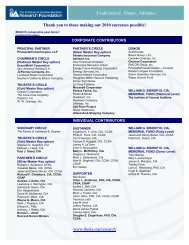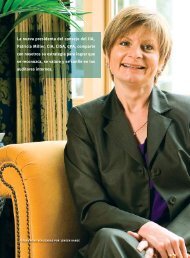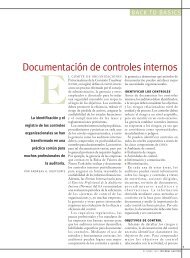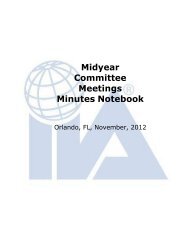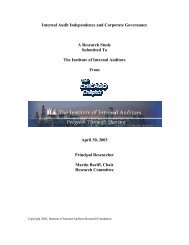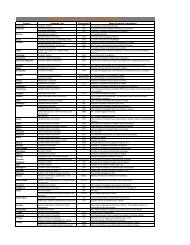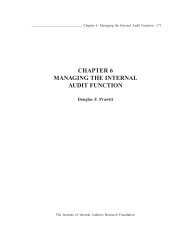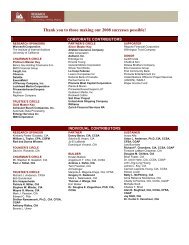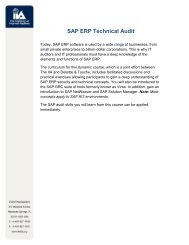Chapter 1.pmd - The Institute of Internal Auditors
Chapter 1.pmd - The Institute of Internal Auditors
Chapter 1.pmd - The Institute of Internal Auditors
Create successful ePaper yourself
Turn your PDF publications into a flip-book with our unique Google optimized e-Paper software.
2 Research Opportunities in <strong>Internal</strong> Auditing _________________________________<br />
I. Background<br />
<strong>The</strong> establishment, growth, and evolution <strong>of</strong> the contemporary internal auditing pr<strong>of</strong>ession<br />
is closely intertwined with the history <strong>of</strong> <strong>The</strong> <strong>Institute</strong> <strong>of</strong> <strong>Internal</strong> <strong>Auditors</strong> (IIA), an<br />
organization founded in the United States in 1941. In the recently released edition <strong>of</strong> 60<br />
Years <strong>of</strong> Progress Through Sharing, chronicling the history <strong>of</strong> <strong>The</strong> IIA, internal auditing<br />
historian Dale L. Flesher notes:<br />
“<strong>The</strong> IIA’s 60-year history is illustrious and each <strong>of</strong> the highlights featured in this 10year<br />
narration [supplementing the 50-year history <strong>of</strong> <strong>The</strong> IIA] have contributed to<br />
the organization that <strong>The</strong> IIA is today:<br />
• <strong>The</strong> primary international pr<strong>of</strong>essional association dedicated to the promotion<br />
and development <strong>of</strong> the practice <strong>of</strong> internal auditing.<br />
• <strong>The</strong> recognized authority, chief educator, and acknowledged leader in standards,<br />
certification, research, and technological guidance for the pr<strong>of</strong>ession worldwide.<br />
• Global headquarters for 76,400 members in 141 countries.” (Flesher & McIntosh,<br />
2002, ix)<br />
Considering <strong>The</strong> IIA’s rather humble origins — a small band <strong>of</strong> 24 charter members<br />
who held the inaugural IIA meeting in New York City 1 on December 9, 1941 — this<br />
worldwide expansion, continuing relevance, and increasing influence and recognition<br />
<strong>of</strong> <strong>The</strong> IIA and the internal auditing pr<strong>of</strong>ession over the last 60 years constitutes<br />
remarkable growth and progress. Indeed, the internal auditing pr<strong>of</strong>ession certainly<br />
appears poised for continued dynamic growth and promises to become “a pr<strong>of</strong>ession<br />
for the 21 st century.” 2<br />
II. <strong>Internal</strong> Auditing: An Historical Perspective<br />
<strong>The</strong> demand for both external and internal auditing is sourced in the need to have some<br />
means <strong>of</strong> independent verification to reduce record-keeping errors, asset misappropriation,<br />
and fraud within business and nonbusiness organizations. <strong>The</strong> roots <strong>of</strong> auditing, in general,<br />
are intuitively described by accounting historian Richard Brown (1905, quoted in Mautz &<br />
Sharaf, 1961) as follows:<br />
“<strong>The</strong> origin <strong>of</strong> auditing goes back to times scarcely less remote than that <strong>of</strong><br />
accounting…Whenever the advance <strong>of</strong> civilization brought about the necessity <strong>of</strong><br />
one man being intrusted to some extent with the property <strong>of</strong> another, the advisability<br />
<strong>of</strong> some kind <strong>of</strong> check upon the fidelity <strong>of</strong> the former would become apparent.”<br />
<strong>The</strong> <strong>Institute</strong> <strong>of</strong> <strong>Internal</strong> <strong>Auditors</strong> Research Foundation



